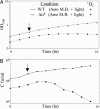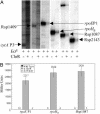A transcriptional response to singlet oxygen, a toxic byproduct of photosynthesis
- PMID: 15855269
- PMCID: PMC1088386
- DOI: 10.1073/pnas.0502225102
A transcriptional response to singlet oxygen, a toxic byproduct of photosynthesis
Abstract
The ability of phototrophs to convert light into biological energy is critical for life on Earth. However, there can be deleterious consequences associated with this bioenergetic conversion, including the production of toxic byproducts. For example, singlet oxygen (1O2) can be formed during photosynthesis by energy transfer from excited triplet-state chlorophyll pigments to O2. By monitoring gene expression and growth in the presence of 1O2, we show that the phototrophic bacterium Rhodobacter sphaeroides mounts a transcriptional response to this reactive oxygen species (ROS) that requires the alternative sigma factor, sigma(E). An increase in sigma(E) activity is seen when cells are exposed to 1O2 generated either by photochemistry within the photosynthetic apparatus or the photosensitizer, methylene blue. Wavelengths of light responsible for the generating triplet-state chlorophyll pigments in the photosynthetic apparatus are sufficient for a sustained increase in sigma(E) activity. Continued exposure to 1O2 is required to maintain this transcriptional response, and other ROS do not cause a similar increase in sigma(E)-dependent gene expression. When a sigma(E) mutant produces low levels of carotenoids, 1O2 is bacteriocidal, suggesting that this response is essential for protecting cells from this ROS. In addition, global gene expression analysis identified approximately 180 genes (approximately 60 operons) whose RNA levels increase > or = 3-fold in cells with increased sigma(E) activity. Gene products encoded by four newly identified sigma(E)-dependent operons are predicted to be involved in stress response, protecting cells from 1O2 damage, or the conservation of energy.
Figures




Similar articles
-
Proteins needed to activate a transcriptional response to the reactive oxygen species singlet oxygen.mBio. 2013 Jan 8;4(1):e00541-12. doi: 10.1128/mBio.00541-12. mBio. 2013. PMID: 23300250 Free PMC article.
-
Singlet oxygen stress in microorganisms.Adv Microb Physiol. 2011;58:141-73. doi: 10.1016/B978-0-12-381043-4.00004-0. Adv Microb Physiol. 2011. PMID: 21722793 Review.
-
Organization and evolution of the biological response to singlet oxygen stress.J Mol Biol. 2008 Nov 14;383(3):713-30. doi: 10.1016/j.jmb.2008.08.017. Epub 2008 Aug 13. J Mol Biol. 2008. PMID: 18723027 Free PMC article.
-
Protein synthesis patterns reveal a complex regulatory response to singlet oxygen in Rhodobacter.J Proteome Res. 2007 Jul;6(7):2460-71. doi: 10.1021/pr060624p. Epub 2007 May 31. J Proteome Res. 2007. PMID: 17536848
-
Shedding light on a Group IV (ECF11) alternative σ factor.Mol Microbiol. 2019 Aug;112(2):374-384. doi: 10.1111/mmi.14280. Epub 2019 May 31. Mol Microbiol. 2019. PMID: 31111523 Free PMC article. Review.
Cited by
-
Diurnal cycles drive rhythmic physiology and promote survival in facultative phototrophic bacteria.ISME Commun. 2023 Nov 24;3(1):125. doi: 10.1038/s43705-023-00334-5. ISME Commun. 2023. PMID: 38001234 Free PMC article.
-
Development of the bacterial photosynthetic apparatus.Curr Opin Microbiol. 2006 Dec;9(6):625-31. doi: 10.1016/j.mib.2006.10.005. Epub 2006 Oct 20. Curr Opin Microbiol. 2006. PMID: 17055774 Free PMC article. Review.
-
Oxidative stress and starvation in Dinoroseobacter shibae: the role of extrachromosomal elements.Front Microbiol. 2015 Mar 25;6:233. doi: 10.3389/fmicb.2015.00233. eCollection 2015. Front Microbiol. 2015. PMID: 25859246 Free PMC article.
-
Proteins needed to activate a transcriptional response to the reactive oxygen species singlet oxygen.mBio. 2013 Jan 8;4(1):e00541-12. doi: 10.1128/mBio.00541-12. mBio. 2013. PMID: 23300250 Free PMC article.
-
A bacterial biosynthetic pathway for methylated furan fatty acids.J Biol Chem. 2020 Jul 17;295(29):9786-9801. doi: 10.1074/jbc.RA120.013697. Epub 2020 May 20. J Biol Chem. 2020. PMID: 32434926 Free PMC article.
References
Publication types
MeSH terms
Substances
Grants and funding
LinkOut - more resources
Full Text Sources
Other Literature Sources
Molecular Biology Databases

